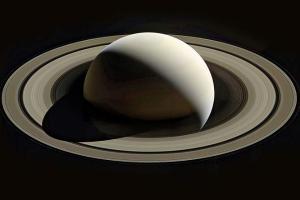The finding, published in the journal Science, show that the rings are relatively recent, having originated less than 100 million years ago and perhaps as recently as 10 million years ago

One of the last full views of Saturn by the Cassini spacecraft acquired at a distance of approximately 8,70,000 miles. Pic/AFP
London: Saturn's spectacular rings are very young - no more than 100 million years old, when dinosaurs still walked the Earth, scientists using data from the Cassini spacecraft have found. Precise measurements of Cassini's final trajectory allowed scientists led by Sapienza University of Rome in Italy to make the first accurate estimate of the amount of material in Saturn's rings, weighing them based on the strength of their gravitational pull.
ADVERTISEMENT
The finding, published in the journal Science, show that the rings are relatively recent, having originated less than 100 million years ago and perhaps as recently as 10 million years ago.
Their young age puts to rest a long-running argument among planetary scientists. Some thought that the rings formed along with the planet 4.5 billion years ago from icy debris remaining in orbit after the formation of the solar system, researchers said. Others thought the rings were very young and that Saturn had, at some point, captured an object from the Kuiper belt or a comet and gradually reduced it to orbiting rubble, they said.
The new mass estimate is based on a measurement of how much the flight path of Cassini was deflected by the gravity of the rings when the spacecraft flew between the planet and the rings on its final set of orbits in September 2017.
62
No. of Saturn's satellites
Catch up on all the latest Crime, National, International and Hatke news here. Also download the new mid-day Android and iOS apps to get latest updates
This story has been sourced from a third party syndicated feed, agencies. Mid-day accepts no responsibility or liability for its dependability, trustworthiness, reliability and data of the text. Mid-day management/mid-day.com reserves the sole right to alter, delete or remove (without notice) the content in its absolute discretion for any reason whatsoever
 Subscribe today by clicking the link and stay updated with the latest news!" Click here!
Subscribe today by clicking the link and stay updated with the latest news!" Click here!







